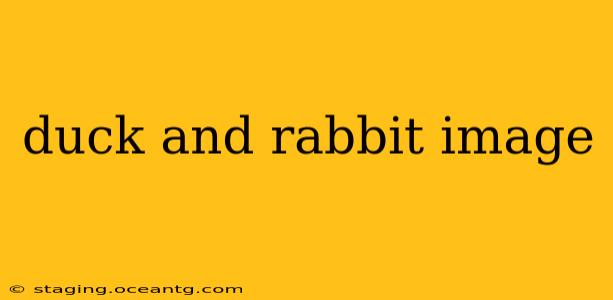The duck-rabbit image is a classic example of a bistable image, a figure that can be perceived in two distinct ways. This seemingly simple drawing has captivated psychologists, artists, and the general public for over a century, sparking discussions about perception, ambiguity, and the nature of reality itself. Its enduring appeal lies in its ability to highlight the active role our brains play in interpreting the world around us. This isn't just a fun optical illusion; it's a window into the fascinating complexities of human perception.
What is the Duck-Rabbit Illusion?
The duck-rabbit illusion is a line drawing that can be interpreted as either a duck's head facing left or a rabbit's head facing right. The same lines and shapes form both interpretations, demonstrating how our brains can actively construct different meanings from the same visual input. There's no objectively "correct" interpretation; the image itself is ambiguous, allowing for multiple valid perceptions. This ambiguity is key to its power as an illustration of perceptual flexibility.
How Does the Duck-Rabbit Illusion Work?
The illusion works because our brains are constantly trying to make sense of the visual world. We use prior experiences, expectations, and context to interpret incoming sensory information. In the case of the duck-rabbit, the same lines can be interpreted in different ways depending on which features your brain chooses to emphasize. If you focus on the left side, you see a beak and eye; if you focus on the right, you see ears and a nose. This highlights the constructive nature of perception – we are not simply passive recipients of sensory input, but active interpreters who build meaning based on our individual experiences and biases.
Why is the Duck-Rabbit Illusion Important?
The duck-rabbit illusion's importance extends far beyond its entertaining nature. It serves as a crucial illustration of several key concepts in psychology and cognitive science:
-
Top-down processing: Our brains use existing knowledge and expectations to shape our perceptions. We don't just passively receive sensory data; we actively interpret it based on prior experiences. The duck-rabbit illustrates this "top-down" processing perfectly, showing how our pre-existing understanding of ducks and rabbits influences our interpretation of the ambiguous image.
-
Perceptual ambiguity: This illusion demonstrates that not all visual input has a single, unambiguous interpretation. The same stimulus can give rise to multiple distinct perceptions, highlighting the limitations and flexibility of our perceptual systems.
-
Figure-ground relationships: The duck-rabbit subtly plays with figure-ground relationships, the way we distinguish between an object (figure) and its background (ground). Depending on your interpretation, different parts of the image become the figure and ground.
What are Some Other Examples of Bistable Images?
The duck-rabbit is just one example of a bistable image. Many other similar illusions exist, each demonstrating the same fundamental principles of perceptual ambiguity and top-down processing. These often involve ambiguous shapes or patterns that can be interpreted in multiple ways, depending on the observer's focus and expectations. Looking into other bistable images can deepen your understanding of this fascinating aspect of human perception.
Can you switch between seeing the duck and the rabbit at will?
Many people find that they can consciously switch back and forth between seeing the duck and the rabbit, although some find it easier than others. The ability to consciously control the perception is a testament to the active and flexible nature of our visual system. Practicing focusing on different features of the image can help improve your ability to switch between the two interpretations.
Is the duck-rabbit illusion a test of intelligence?
No, the duck-rabbit illusion is not a test of intelligence. The ability to perceive both the duck and the rabbit is not indicative of higher or lower cognitive abilities. It simply highlights the flexibility and ambiguity inherent in visual perception. Everyone experiences this illusion differently, showcasing the individual nature of perception.
What is the history of the duck-rabbit illusion?
The exact origin of the duck-rabbit image is somewhat uncertain, but its popularity was significantly boosted by its use in the writings of the renowned psychologist Joseph Jastrow at the end of the 19th century. Since then, it's become a staple in discussions about perception and cognitive science, appearing in textbooks and popular science articles alike. Its enduring legacy reflects its ability to concisely communicate complex ideas about the nature of perception.
The duck-rabbit illusion remains a powerful and compelling example of how our perception isn't simply a passive reception of sensory information, but an active, constructive process shaped by experience and context. Its enduring fascination underscores the ongoing mystery and wonder of the human mind.
